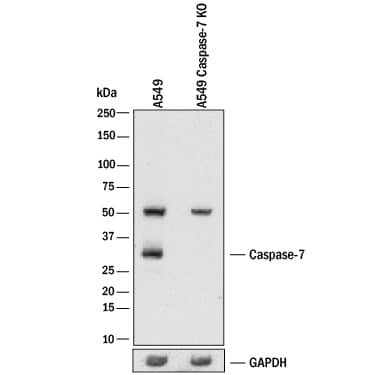Human/Mouse Caspase-7 Antibody
R&D Systems, part of Bio-Techne | Catalog # MAB823

Key Product Details
Validated by
Species Reactivity
Validated:
Cited:
Applications
Validated:
Cited:
Label
Antibody Source
Product Specifications
Immunogen
Accession # P55210
Specificity
Clonality
Host
Isotype
Scientific Data Images for Human/Mouse Caspase-7 Antibody
Detection of Human and Mouse Caspase‑7 Precursor and Large Subunit by Western Blot.
Western blot shows lysates of Jurkat human acute T cell leukemia cell line and DA3 mouse myeloma cell line untreated (-) or treated (+) with 1 µM staurosporine (STS) for the indicated times. PVDF membrane was probed with 0.5 µg/mL of Human/Mouse Caspase-7 Monoclonal Antibody (Catalog # MAB823), followed by HRP-conjugated Anti-Mouse IgG Secondary Antibody (Catalog # HAF007). Specific bands were detected for Caspase-7 precursor and large subunit at approximately 38 and 20 kDa (as indicated). This experiment was conducted under reducing conditions and using Immunoblot Buffer Group 4.Western Blot Shows Human Caspase‑7 Specificity by Using Knockout Cell Line.
Western blot shows lysates of A549 human lung carcinoma parental cell line and Caspase-7 knockout A549 cell line (KO). PVDF membrane was probed with 0.5 µg/mL of Mouse Anti-Human/Mouse Caspase-7 Monoclonal Antibody (Catalog # MAB823) followed by HRP-conjugated Anti-Mouse IgG Secondary Antibody (Catalog # HAF018). A specific band was detected for Caspase-7 at approximately 32 kDa (as indicated) in the parental A549 cell line, but is not detectable in knockout A549 cell line. GAPDH (Catalog # MAB5718) is shown as a loading control. This experiment was conducted under reducing conditions and using Immunoblot Buffer Group 1.Applications for Human/Mouse Caspase-7 Antibody
Knockout Validated
Western Blot
Sample: Staurosporine-treated Jurkat human acute T cell leukemia cell line and DA3 mouse myeloma cell line
Formulation, Preparation, and Storage
Purification
Reconstitution
Formulation
Shipping
Stability & Storage
- 12 months from date of receipt, -20 to -70 °C as supplied.
- 1 month, 2 to 8 °C under sterile conditions after reconstitution.
- 6 months, -20 to -70 °C under sterile conditions after reconstitution.
Background: Caspase-7
Caspase-7 (Cysteine-aspartic acid protease 7/Casp7; also CMH-1, ICE-LAP3 and Mch3) is a 32 kDa member of the peptidase C14A/IL-1 beta-converting family of enzymes (1, 2, 3). It is widely expressed, except in brain, and is best known as an integral component of the apoptotic cascade. Caspase-7 is considered to be an executioner caspase, as a downstream mediator of apoptotic-associated proteolysis (2, 3). Upon activation, Caspase-7 is known to utilize a Cys residue to cleave multiple substrates, including PARP, procaspase 6, Gas2 and calpstatin (1). Human procaspase-7 is a 34 - 36 kDa, 303 amino acid (aa) protein (4, 5, 6). Normally, it is an inactive homodimer (1, 2, 7, 8). But following an upstream signal that activates processing proteases, procaspase-7 undergoes proteolytic cleavage to generate an N-terminal 23 aa propeptide, a 175 aa p20/20 kDa subunit (aa 24 - 198), and a 105 aa C-terminal p12/12 kDa subunit (5). The p20 and p12 subunits noncovalently heterodimerize, and subsequently associate with another p20/p12 heterodimer to form an active antiparallel homodimer. Additional processing of p20 may remove aa 24 - 36 to generate p18, while additional processing of p12 will remove aa 199 - 206 to generate p11 (9, 10). Multiple proteases can use Caspase-7 as a substrate, and include caspase-1, -3, -8, and -10, granzyme B, calpain-1 and Caspase-7 itself (3, 6, 9, 11). Caspase-7 is found in both cytosol and nucleus, and possesses a potential KKKK nuclear localization signal between aa 38 - 41 that likely undergoes sumoylation (9, 12). There are two potential isoform variants, one which shows an alternate start site 33 aa upstream of the standard start site, and a second that shows a 105 aa substitution for aa 149 - 303. Human and mouse Caspase-7 are 82% aa identical at the amino acid level.
References
- Chowdhury, I. et al. (2008) Comp. Biochem. Physiol. B 151:10.
- Boatright, K.M. and G.S. Salvesen (2003) Curr. Opin. Cell Biol. 15:725.
- Launay, S. et al. (2005) Oncogene 24:5137.
- Juan, T. et al. (1997) Genomics 40:86.
- Fernandez-Alnemri, T. et al. (1995) Cancer Res. 55:6045.
- Fernandez-Alnemri, T. et al. (1996) Proc. Natl. Acad. Sci. USA 93:7464.
- Gao, Z. et al. (2007) J. Biol. Chem. 282:30718.
- Riedl, S.J. et al. (2001) Proc. Natl. Acad. Sci. USA 98:14790.
- Gafni, J. et al. (2009) J. Biol. Chem. July 21 [epub ahead of print].
- Lippke, J.A. et al. (1996) J. Biol. Chem. 271:1825.
- Lamkanfi, M. et al. (2008) Mol. Cell. Proteomics 7:2350.
- Hayashi, N. et al. (2006) Neurosci. Lett. 397:5.
Alternate Names
Gene Symbol
UniProt
Additional Caspase-7 Products
Product Documents for Human/Mouse Caspase-7 Antibody
Product Specific Notices for Human/Mouse Caspase-7 Antibody
For research use only

